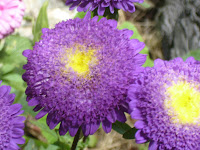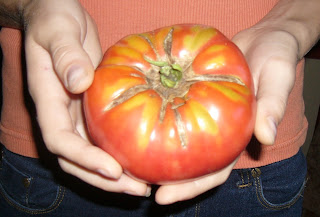Sometimes I look around my garden and every patch I remember weeding suddenly resembles the Amazon Jungle of Weeds. How did that happen so quickly and why is gardening so much like housework - it NEVER ends! And just when you seem to have completed a round of hardcore work, you're right back to where you started - and you simply have to begin all over again. An endless cycle of work, work, work!
It's when I have this realisation that I feel old. Really old! We have had so much rain over the last week and a bit, that the weeds have doubled, or tripled in size and amount.
People say you're only as old as you feel, but days like this, I feel 80-plus some!
But on a brighter note, today is the last day that my "baby" girl is 15 - tomorrow she will be Sweet 16. Most 16's are anything BUT sweet, but my girl is super-sweet! I have this theory: when your little child is a right royal demon, they turn into angels when they become teens and vice versa. Well, it's a theory that can only stand up to the test in our house perhaps, as she used to be a little monster but she has grown so tall, so wise and so beautiful - and beautiful on the outside too.
It's like tending my garden; when I have these little seeds I plant, I watch over them, anticipate their "birth" with great excitement and when I see their little green heads poke up out of the soil, I am ecstatic with the euphoria of having given life............... I eagerly water them, making sure they get enough sunshine, not too much heat, anticipating their needs, feeding them and then finally planting them out into the garden where I still tend them, but less urgently as much of their needs are taken care of by the sun and the rain. Then one day you look out on your garden and you draw an audible intake of breath as you gaze on the beauty of the plant that you have sporadically cared for - suddenly it is magnificent in it's own beauty! And it got that way, much on it's own.
Kinda like how I feel about our kids. The nurturing and the growing of them.
Today I dug up the first real cache of Jerusalem artichokes. They are a tuberous vegetable, belonging to the sunflower family but mistakenly botany-identified as artichokes. My gardening book also states that they do not come from Jerusalem either! Strangely misleading name altogether then. However, when scrubbed clean, these knobbly little critters are a taste sensation like no other, drizzled with olive oil and sprinkled with a little sea salt. They are said to give one a case of "foul flatulence after mass consumption" but who cares? Would you eat less chocolate if it made you, ............. you know......? Fart. Doubt it.
Anyway, I think we shall be giving them away in bucketloads - simply because we have so many of them. One tuber can yeild a small bucketful of produce - I must have planted about 16 tubers (not to mention the ones left over from the last raiding of treasures - like potatoes, it is easy to overlook pocketfuls of them when harvesting. Oh, and did I mention the flower? The crowning glory is a mass of small sunflower-like flowers towering 2 1/2 to 3 m tall! A reason to plant them on that account only.
Tall and beautiful, just like my daughter.
It's when I have this realisation that I feel old. Really old! We have had so much rain over the last week and a bit, that the weeds have doubled, or tripled in size and amount.
People say you're only as old as you feel, but days like this, I feel 80-plus some!
But on a brighter note, today is the last day that my "baby" girl is 15 - tomorrow she will be Sweet 16. Most 16's are anything BUT sweet, but my girl is super-sweet! I have this theory: when your little child is a right royal demon, they turn into angels when they become teens and vice versa. Well, it's a theory that can only stand up to the test in our house perhaps, as she used to be a little monster but she has grown so tall, so wise and so beautiful - and beautiful on the outside too.
It's like tending my garden; when I have these little seeds I plant, I watch over them, anticipate their "birth" with great excitement and when I see their little green heads poke up out of the soil, I am ecstatic with the euphoria of having given life............... I eagerly water them, making sure they get enough sunshine, not too much heat, anticipating their needs, feeding them and then finally planting them out into the garden where I still tend them, but less urgently as much of their needs are taken care of by the sun and the rain. Then one day you look out on your garden and you draw an audible intake of breath as you gaze on the beauty of the plant that you have sporadically cared for - suddenly it is magnificent in it's own beauty! And it got that way, much on it's own.
Kinda like how I feel about our kids. The nurturing and the growing of them.
Today I dug up the first real cache of Jerusalem artichokes. They are a tuberous vegetable, belonging to the sunflower family but mistakenly botany-identified as artichokes. My gardening book also states that they do not come from Jerusalem either! Strangely misleading name altogether then. However, when scrubbed clean, these knobbly little critters are a taste sensation like no other, drizzled with olive oil and sprinkled with a little sea salt. They are said to give one a case of "foul flatulence after mass consumption" but who cares? Would you eat less chocolate if it made you, ............. you know......? Fart. Doubt it.
Anyway, I think we shall be giving them away in bucketloads - simply because we have so many of them. One tuber can yeild a small bucketful of produce - I must have planted about 16 tubers (not to mention the ones left over from the last raiding of treasures - like potatoes, it is easy to overlook pocketfuls of them when harvesting. Oh, and did I mention the flower? The crowning glory is a mass of small sunflower-like flowers towering 2 1/2 to 3 m tall! A reason to plant them on that account only.
Tall and beautiful, just like my daughter.
















